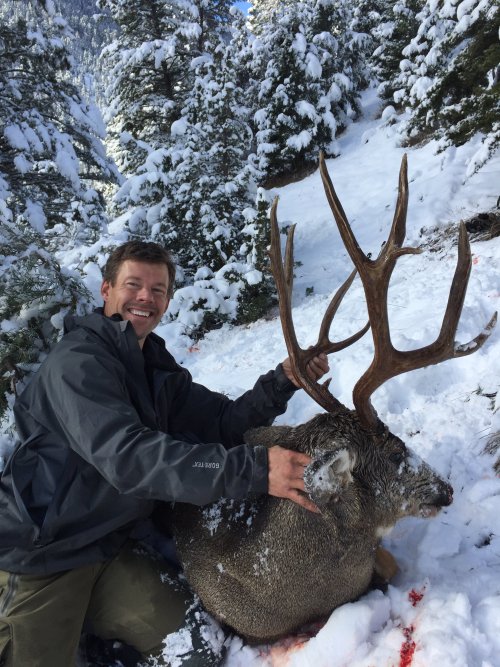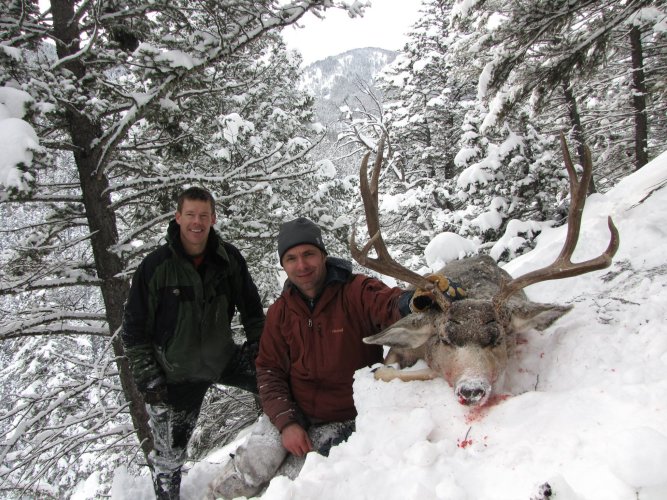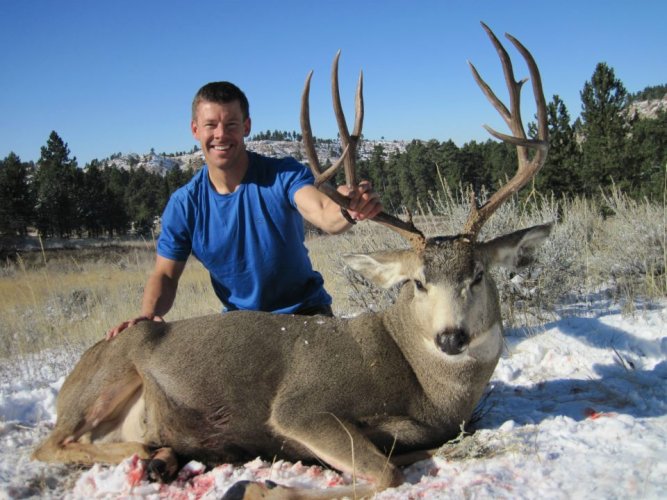sclancy27
Well-known member
- Joined
- Nov 23, 2022
- Messages
- 742
I'm have high confidence that the incidental take of mule deer by elk hunters happens a lot in R3 and way more than people realize in R7, which is also addressed in the proposal.
Follow along with the video below to see how to install our site as a web app on your home screen.
Note: This feature may not be available in some browsers.
And region 6, I've done it.I'm have high confidence that the incidental take of mule deer by elk hunters happens a lot in R3 and way more than people realize in R7, which is also addressed in the proposal.
I live and work in R6. I haven't killed a mule deer buck in R6 since 2003. Lots of folks think it is awesome though.And region 6, I've done it.
Always pays to have a pocket full of tags to use when you’re hunting elk in November.I'm have high confidence that the incidental take of mule deer by elk hunters happens a lot in R3 and way more than people realize in R7, which is also addressed in the proposal.



The “come home to hunt “ and other (stupid) special interest tags are actually pretty insignificant. But if we could do away with them all I’d be for itDid they tak at all about the “come home to hunt” tag sales? Maybe it’s not a needle mover but it seems like it’s awfully generous of FWP to sell those tags at such a discount.
Dang good I’d say.I live and work in R6. I haven't killed a mule deer buck in R6 since 2003. Lots of folks think it is awesome though.
Buck in middle pic is oldestAlways pays to have a pocket full of tags to use when you’re hunting elk in November.
Region 3 elk hunts..
View attachment 326456
View attachment 326458
Region 7 elk hunt..
View attachment 326459
I think so - and the bottom one had the most potential (youngest)Buck in middle pic is oldest
One
Do you work for the dept, by chance??Little late back to the party, but I'll take this on.......I have done the research; I have been in those areas; I have hunted Eastern Montana the last 30 yrs; I understand the landscape and have talked to many biologists in other states. Have spent considerable time in Wyoming.
Your comparing Eastern Montana to the Snowy Range, Laramie Range and Sierra Madres?? Your comparing G and H in Wyoming to Eastern Montana??
G and H are de facto LE regions for non-residents; and combined with the ruggedness of all these areas, they naturally, severely, limit access. These areas are also not as productive mule deer herds as Eastern Montana; they are subjected to harder winters, and have had their winter range degraded by sub-divisions and all kinds of other human affects.
A 30 day October season in Eastern Montana, where human access is easy and deer are not migratory, is not going to have the same effect. Your neighboring States with similar habitat and October seasons is proof that easy access areas don't really benefit much from October seasons.
Have hunted many of the western Wyoming non resident and resident LE hunts (many times), they used to be fairly easy to get in the 90's and early 2000's; all LE, all very few tags given out, some with short October seasons, and they have been this way for decades; are the overall deer numbers suddenly spectacular because of it?? Nope......you should do your research.........because killing bucks in October vs November does nothing to increase the number of animals on the landscape other than a possible slight increase in bucks, even if that is achievable. And limiting the amount of bucks killed doesn't do anything to increase the overall herd size. Yup.....it does the trick for better buck to doe ratio's and it does the trick for better age classes, but, increasing the size of the overall herd?? No.......
What you guys are really wanting, and the "secret" here is you want better buck to doe ratios, but, you really want a better age structure. Thats a worthy goal. But there are rule structures that enable this......its called move it all to LE. But your wrapping the "we gotta save the mule deer herd" into a regulation scheme that is really about you wanting a better age class.
The problem is in Region 6 and Region 7 you had a devastating drought coupled with a hard winter coupled with high antlerless harvest that all hit at one time; that is what caused the current problem.......not shooting bucks in November...........
Region 7 Biologist quote in 2019:
“Mule deer are looking good,” Foster said, “Numbers are 5 percent below last year but still 27 percent above long-term average.”
Foster determines long-term average by tracing survey data back to the 1996-97 season and harvest figures back to 1976.
Surveys show mule deer population density in southeast Montana has been increasing since about 2012, when deer numbers began to rebound from a crash following back-to-back bitter winters. In 2015, deer reached the highest density recorded in the past three decades."
Region 6 Biologist quote in 2019:
Overall, numbers seen during spring surveys showed region-wide population at 56 percent above average. Due to increasing quota numbers, there may be surplus tags still available in some districts.
Winter mortality was variable across the region during the 2018-2019 winter but likely was minimal based on observations and reports. “A small amount of winter mortality was observed throughout the region,” says Outlook-area biologist Ryan Williamson, “with mostly fawns succumbing to the harsher late winter weather. Generally speaking, the mule deer appeared to have overwintered well.”
So, yes......I do talk to biologists and actually read facts and not internet conjecture..........these quotes from 2019 jive exactly with what we saw in those regions in 2019. The bottom line is you guys want older bucks.......like I said, worthy goal, then do what you need to do and get more LE units......but don't wrap "save the herd" around that goal.........
AgreedI think so - and the bottom one had the most potential (youngest)
Reminds me of in 2009 when asking a guy here “you work for Eastmans?”. I wasn’t as tactful maybe as you are.Do you work for the dept, by chance??
I am being specific to R6.Dang good I’d say.
2003 was last Mule deer I killed too.
Mtmiller hiding his stockpile of giant muleys..I am being specific to R6.
I wasn’t. I have not pulled the trigger since ‘03….2003 not 1903I am being specific to R6.
Little late back to the party, but I'll take this on.......I have done the research; I have been in those areas; I have hunted Eastern Montana the last 30 yrs; I understand the landscape and have talked to many biologists in other states. Have spent considerable time in Wyoming.
Your comparing Eastern Montana to the Snowy Range, Laramie Range and Sierra Madres?? Your comparing G and H in Wyoming to Eastern Montana??
G and H are de facto LE regions for non-residents; and combined with the ruggedness of all these areas, they naturally, severely, limit access. These areas are also not as productive mule deer herds as Eastern Montana; they are subjected to harder winters, and have had their winter range degraded by sub-divisions and all kinds of other human affects.
A 30 day October season in Eastern Montana, where human access is easy and deer are not migratory, is not going to have the same effect. Your neighboring States with similar habitat and October seasons is proof that easy access areas don't really benefit much from October seasons.
Have hunted many of the western Wyoming non resident and resident LE hunts (many times), they used to be fairly easy to get in the 90's and early 2000's; all LE, all very few tags given out, some with short October seasons, and they have been this way for decades; are the overall deer numbers suddenly spectacular because of it?? Nope......you should do your research.........because killing bucks in October vs November does nothing to increase the number of animals on the landscape other than a possible slight increase in bucks, even if that is achievable. And limiting the amount of bucks killed doesn't do anything to increase the overall herd size. Yup.....it does the trick for better buck to doe ratio's and it does the trick for better age classes, but, increasing the size of the overall herd?? No.......
What you guys are really wanting, and the "secret" here is you want better buck to doe ratios, but, you really want a better age structure. Thats a worthy goal. But there are rule structures that enable this......its called move it all to LE. But your wrapping the "we gotta save the mule deer herd" into a regulation scheme that is really about you wanting a better age class.
The problem is in Region 6 and Region 7 you had a devastating drought coupled with a hard winter coupled with high antlerless harvest that all hit at one time; that is what caused the current problem.......not shooting bucks in November...........
Region 7 Biologist quote in 2019:
“Mule deer are looking good,” Foster said, “Numbers are 5 percent below last year but still 27 percent above long-term average.”
Foster determines long-term average by tracing survey data back to the 1996-97 season and harvest figures back to 1976.
Surveys show mule deer population density in southeast Montana has been increasing since about 2012, when deer numbers began to rebound from a crash following back-to-back bitter winters. In 2015, deer reached the highest density recorded in the past three decades."
Region 6 Biologist quote in 2019:
Overall, numbers seen during spring surveys showed region-wide population at 56 percent above average. Due to increasing quota numbers, there may be surplus tags still available in some districts.
Winter mortality was variable across the region during the 2018-2019 winter but likely was minimal based on observations and reports. “A small amount of winter mortality was observed throughout the region,” says Outlook-area biologist Ryan Williamson, “with mostly fawns succumbing to the harsher late winter weather. Generally speaking, the mule deer appeared to have overwintered well.”
So, yes......I do talk to biologists and actually read facts and not internet conjecture..........these quotes from 2019 jive exactly with what we saw in those regions in 2019. The bottom line is you guys want older bucks.......like I said, worthy goal, then do what you need to do and get more LE units......but don't wrap "save the herd" around that goal.........
I’d say that if you let more mule deer doe survive on public, then the bucks wouldn’t have to travel as far between dense herds on private and thereby limit the spread that way.So Just going to throw this out here again. I commend all the work and effort here BUT......
The Department, nor the scientists working on CWD want no more deer. Period!
Any proposal and management strategy will have mediocre results with less deer allowed to live. Lets address these things in the proper order.
Also letting more does survive on public is going to pull more bucks from private to public during the rut. Then more can get killed to make fwp happyI’d say that if you let more mule deer doe survive on public, then the bucks wouldn’t have to travel as far between dense herds on private and thereby limit the spread that way.
A little reverse psychology. I like it.Also letting more does survive on public is going to pull more bucks from private to public during the rut. Then more can get killed to make fwp happy